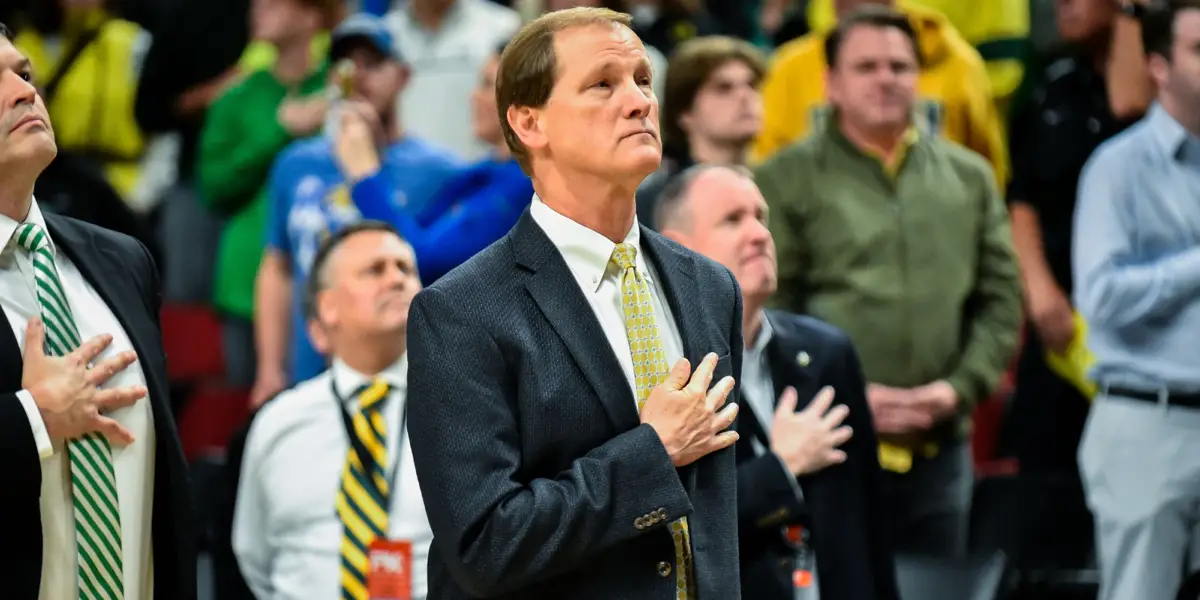Dana Altman is known for his spread offense and his match-up zone defense. While the offense gets adjusted every year to fit personnel, the defense has remained the same and is a key to Oregon’s success.
Altman’s zone defense is different than most generic 2-3 zone defenses that teams face. It uses a lot of man-to-man principles to cover holes and confuse the offense. While other coaches use a match up zone defense as well, not many stick with it as much as often Altman does.
The key to this defense is having quick guards with long, athletic wings and posts that can guard the three point line. Ideally, there would be a shot blocker in the middle, and as we have seen this year, the Ducks have struggled at times defending around the basket with no shot blocker.
First, let’s look look at a typical 2-3 zone defense and how they defend a cutting player along the baseline to create an overload.
In the video above we can see that the Ducks cut Payton Pritchard through the middle and to the corner, causing an overload to that side. In doing so, we can see that No. 11 for Washington at the top of the screen initially has no one to guard, leaving Pritchard open in the corner, even though the Ducks are unable to get him the ball.
This is fairly standard for zone defenses, where players will stay within one area, and only guard someone if they enter their zone.
Now, we will see how the Ducks defend players cutting across the baseline.
In the clip above, we see that Chandler Lawson has an active defensive possession. First, he is guarding the post inside. Then, as the ball gets swung to the opposite side, he closes out to the shooter in the corner. Finally, he follows that player all the way to the far corner, forcing a drive where N’Faly Dante is able to contest and block the shot, resulting in a rebound for Lawson.
Another reason this defense is so successful is the ability for every player to switch screens and guard multiple people.
In the possession above, we see Anthony Mathis, CJ Walker and Lawson working around multiple cutters and screens to create a turnover. The key in this play is the versatility by Walker and Lawson. First, Walker is able to deny the post up from No. 35 after the dribble hand off, then after the ball is swung to the other side, he is able to contest the pass from the other post player, No. 22. This leads to a good double team, and an errant pass for a turnover.
Where this defense can struggle is when teams have a lot of player movement, causing confusion about who each defender is supposed to match-up with.
In the play above, Arizona State uses multiple cuts and passes to make Oregon’s defense move. Initially, the Ducks do a good job matching the cutters, however, a cut from the baseline to the top of the key causes Addison Patterson and Pritchard to both close out on the same player, leaving a shooter wide open in the corner. Patterson is able to recover, but the ball handler drives, finding a teammate for a layup with no shot blocker inside.
In any of the clips above, does it ever look like the Ducks are in a 2-3 zone?
That is why this defense is so successful. At a base level, it is still a 2-3 zone, so teams tend to run a zone offense. Generally, zone offenses tend to be more basic and stagnant, looking for gaps in the defense to exploit. With less movement on offense, and no open holes in the defense because defenders are matched up, we see a lot of late shot clock situations for opposing teams.
This defense takes communication, discipline and an understanding of what the opposing offense is trying to do. That is one reason why we see Altman’s teams gradually get better throughout the year, because they start to figure out how to play within the defense.
As the Ducks get into tournament time, watch and see how well this team is communicating and moving on defense. If they are not pointing, talking and flying around, they won’t reach their potential. But, if they are, we could see another fun run in March.
Go Ducks!
Coach Alex Nordstrand
Eugene, OregonTop Photo by Kevin Cline

Chris Brouilette, the FishDuck.com Volunteer editor for this article, is a current student at the University of Oregon from Sterling, Illinois.

Alex is a lifelong Duck fan living in Eugene who goes to every Football and Basketball game that he can, and appreciates his wife for putting up with him during those seasons. Sports have always been his biggest passion, having played and coached Basketball at the High School level. He hopes to bring a unique and deeper understanding of both the Men’s and Women’s basketball teams at Oregon, and looks forward to nerding out with everyone while writing and talking Ducks!


